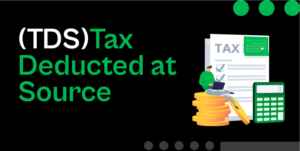![]()

Tax deduction
What is TDS?
TDS stands for Tax Deducted at Source. It is a system introduced by the Income Tax Department of India to collect tax at the origin of income. According to this system, a person (referred to as the deductor) responsible for making certain payments (like salary, rent, professional fees, etc.) is required to deduct a specific percentage of tax before making the payment to the recipient (referred to as the deductee).
The deducted amount is then deposited with the government on behalf of the deductee. The TDS system is applicable to a wide range of payments, including but not limited to:
- Salaries
- Interest payments by banks
- Commission payments
- Rent
- Payments to contractors and freelancers
How Does TDS Work?
The process of TDS can be broken down into a few steps:
1. Deduction of Tax: When a payment covered under TDS provisions is made, the person or entity making the payment (deductor) is require to deduct a certain percentage of tax before the payment is transfer to the recipient (deductee).
2. Deposit of Tax: The deducted amount is then deposit with the Income Tax Department within a specified period. This is done online via the government’s tax payment portal.
3. Issuance of TDS Certificate: After depositing the tax, the deductor is require to provide a TDS certificate (Form 16 or 16A, depending on the nature of payment) to the deductee. This certificate serves as proof that TDS has been deduct and deposited with the government.
4. Filing TDS Returns: The deductor must file TDS returns on a quarterly basis. This return includes details of the payments made, tax deducted, and the PAN of the deductees.
5. Claiming TDS Credit: When the deductee files their income tax return, they can claim credit for the TDS amount deducted, which reduces their overall tax liability.
How is Tax Levied Under TDS?
The rate at which TDS is deduct depends on the type of payment being made. Different types of payments attract different TDS rates, as prescribed by the Income Tax Act, 1961. Here are some examples of common TDS rates:
Salary: TDS on salary is deduct based on the income tax slab rates applicable to the individual.
Interest from Banks: 10% TDS is deduct if the interest earned exceeds ₹40,000 in a financial year.
Rent: TDS on rent payments is typically 10% (for individuals) and 2% for rent of plant and machinery.
Contractor Payments: Payments made to contractors or freelancers attract a 1% TDS for individual contractors and 2% for other contractors.
However, if the recipient does not furnish their Permanent Account Number (PAN), the TDS rate can be higher. Additionally, TDS is not deduct if the recipient provides valid forms (like Form 15G or 15H) stating that their income is below the taxable limit.
TDS and Income Tax Returns (ITR)
TDS is essentially an advance tax, and the deductee can claim credit for the tax deducted while filing their income tax return. Here’s how TDS plays a role in the income tax filing process:
- The deductee adds up all sources of income and calculates the total tax liability for the year.
- The TDS already deducted from their income throughout the year is then subtract from the total tax liability.
- If the TDS deducted is more than the actual tax liability, the deduct can claim a refund from the Income Tax Department.
- Conversely, if the TDS deducted is less than the total tax payable, the deduct needs to pay the balance tax.
Benefits of TDS
- Prevents Tax Evasion: TDS ensures that taxes are collect as income is generate, leaving less room for tax evasion.
- Regular Revenue for the Government: The government receives a steady inflow of funds throughout the year rather than waiting for year-end tax filings.
- Convenience for Taxpayers: Since taxes are deduct automatically at the source, taxpayers don’t need to worry about large lump-sum payments at the end of the year.
For more information to visit: https://www.incometax.gov.in
FAQs
Related Topics
TDS compliance for private limited company?
What are TDS codes?

